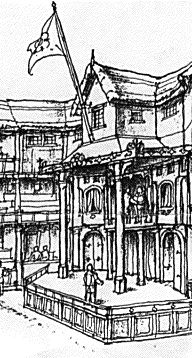What do we really know of the stage?
Reconstructions of Elizabethan stages, like this one of the Rose, are as much the result of deduction and guesswork* as of concrete fact. Many scholars would disagree with some features of the conjecture picured here, especially its "balcony," which projects from the rear wall. A more generally accepted view (one adopted in the New Globe) is that the "balcony" was little more than a window in the tiring-house wall at the back of the stage.
The general structure of the theatres is well known from such documents as carpenters' specifications and the sketch of the Swan, but the actual nature of the stage--the entrances, levels, and so on--is nowhere clearly recorded.
The great advantage of this stage was its flexibility. Since there was little, if any, scenery, scenes could change instantly*.
A more schematic (if less elegant) view of the stage is used in the section that shows how a scene from Hamlet may have been staged.
Footnotes
-
What we do know
The size of the Rose theatre and its stage (smaller than most stages) are known from recent excavation, as is the position of the pillars. Compare the illustration of the Swan theatre.
What we don't know.
Whether the upper stage projected onto the stage below; how many doors there were onto the stage; the location of the "Lords' Room(s)." In this reconstruction there are windows above the main doors onto the stage, but there is a good possibility that the lords' rooms were in this spot.
Not all scholars of the period would agree that the building would be as ornate as it is pictured here.
-
Modern expectations
The locations that appear at the head of scenes in modern editions of Shakespeare were added by editors in the eighteenth and nineteenth centuries, when stage traditions required realistic scenery on a "picture-frame" stage. Imagine the problem such staging would have with the fifteen scenes in Act Four of Antony and Cleopatra! There is also a moment in Romeo and Juliet when the scene changes while Romeo is on stage--from outside the Capulets' walls to inside (2.1-2.2).
Modern stage productions of Shakespeare have returned to the simple staging of Shakespeare's time, where the stage is simply a "place" that changes without resetting the scene. The one major advantage we have is the ability to change the lighting with great subtlety. Shakespeare's plays would have been performed by daylight.
